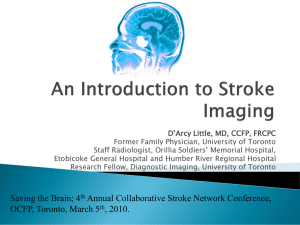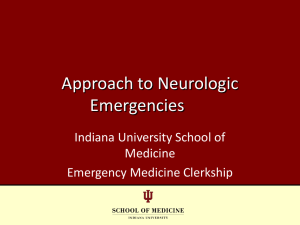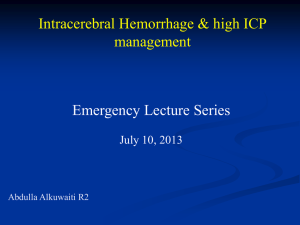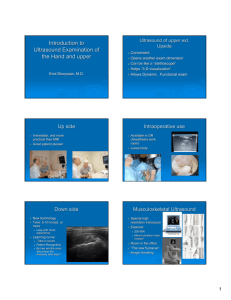Seeing a Stroke - Garden City Hospital
advertisement
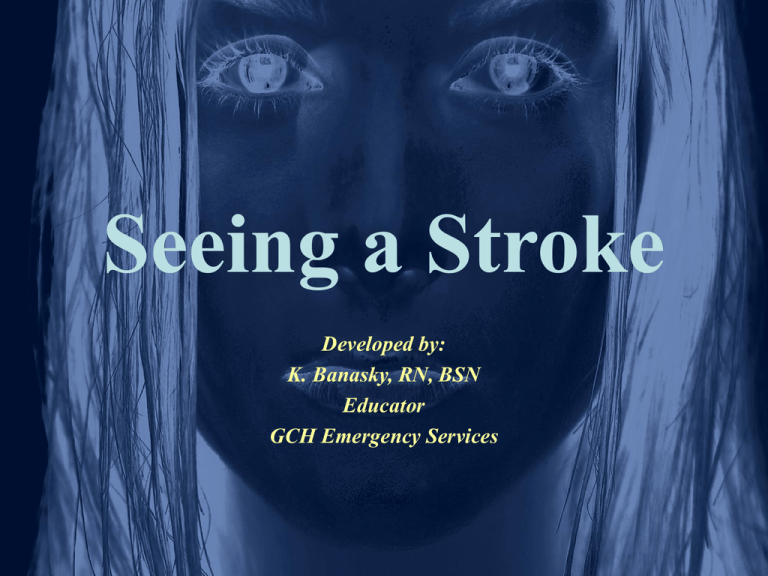
Seeing a Stroke Developed by: K. Banasky, RN, BSN Educator GCH Emergency Services What we know… There are two types of stroke/brain attack: • Ischemic • Hemorrhagic Treatment is based on the type of brain attack a person is having. Efforts by the American Stroke Association, National Stroke Association, and American Heart Association include mass education to the public on brain attack and response. ACT F.A.S.T. • ACT F.A.S.T. is a public education campaign on recognition of Stroke symptoms as an emergency. • ACT F.A.S.T. stands for – F Face: Facial Droop, Uneven Smile – A Arm: Arm numbness, Arm Weakness – S Speech: Slurred speech, Difficulty speaking or understanding – T Time: Call 911 and get to the hospital immediately ACTING FAST When a patient arrives to the Emergency Department with symptoms of a stroke…OR…an admitted patient exhibits symptoms of a stroke, time is critical in determining if a Cerebral Vascular Accident aka CVA is occurring. Obtaining a CT Scan of the Brain is one of the most important evaluation tools for determination of treatment. Why? Time is Tissue CT scan of the brain helps to determine if there is a bleed within the brain. • Evidence of blood, or an active bleed within the brain immediately contraindicates administration of tPA (tissue Plasminogen Activator) • If blood is present, a Neurosurgery consult of the patient is necessary to determine course of care as there is risk of herniation from increased pressures. • If NO blood is evident on the CT scan, treatment commences to reverse the effects of stroke. What Happens The patient is transported to CT via cart/stretcher with RN present. Upon completion, radiology immediately evaluates scan for the presence of blood. If NO evidence of blood exists, the finding is termed “CT Negative”, meaning CT is negative for hemorrhage. Initially a CT may be read as “Negative”; however, ischemia eventually appears. KEYPOINTS: • This indicates ONLY, that the patient does not have evidence of hemorrhage. • CT must be completed within 25 minutes of arrival in the ED or within 25 minutes of recognition of StrokeLike Symptoms. How do we know it is a stroke? • Diagnosis is based on clinical assessment findings and Negative for Hemorrhage Scan. – Clinical diagnosis of Stroke with a measurable deficit – Timeline of events – History by patient or individuals present prior to and during event (i.e. family, friends, staff) – There is no evidence of improvement or reversal of symptoms • KEYPOINT: A CT Scan of the brain will eventually demonstrate signs of Ischemia. Figure 1. Drawings (top) illustrate the territories (blue) of the ACA, middle cerebral artery (MCA) , and posterior cerebral artery. The CT Scan below each drawing shows an infarction of the artery. de Lucas E M et al. Radiographics 2008;28:1673-1687 ©2008 by Radiological Society of North America Figure 12. Hypertension-related macrohemorrhage in an 80-year-old woman with right-sided weakness and a blood pressure of 160/85 mm Hg. The White area showing up within the CT scan of this brain is evidence of hemorrhage. This patient would NOT be a candidate for tPA Chao C P et al. Radiographics 2006;26:1517-1531 ©2006 by Radiological Society of North America Figure 6. CAA-related macrohemorrhage with associated subdural hemorrhage in a 77-yearold man with severe headache and difficulty walking. This patient was documented as having a severe headache and difficulty walking. The large white area indicates Hemorrhage. Chao C P et al. Radiographics 2006;26:1517-1531 ©2006 by Radiological Society of North America Figure 2. Determination of ICH location in a 74-year-old man with acute onset of expressive aphasia, confusion, and a right-sided facial droop. This area within the brain is white and demonstrates hemorrhage. This patient would NOT be a candidate for tPA as the scan demonstrates blood present. Chao C P et al. Radiographics 2006;26:1517-1531 ©2006 by Radiological Society of North America Figure 2a. Early ischemic CT signs. Early ischemic CT signs. CT scans show subtle hypoattenuation and sulcal effacement in the right MCA territory (arrows in 2a) This infers that the area supplied by the MCA is changing due to the lack of nutrient rich blood. de Lucas E M et al. Radiographics 2008;28:1673-1687 ©2008 by Radiological Society of North America Figure 1b. Early infarct in the territory of the left middle cerebral artery in a 52-year-old man. This is an un-enhanced image of a ischemic stroke caused by a thrombus. This would be considered a negative CT meaning “negative for hemorrhage”; however, ischemia is present. Provenzale J M Radiographics 1999;19:1323-1331 ©1999 by Radiological Society of North America Ischemic Stroke Hyperdense MCA Sign Notice the area of brain is not white, but the Middle Cerebral Artery is white, (aka. MCA sign) indicative of an Ischemic Stroke. This CT Scan would be “negative for hemorrhage”; however ischemia is present within this scan. Figure 4a. Acute stroke (2.5 hours evolution) in a 55-year-old man with right hemiplegia. Can you see the stroke? The arrows indicate changes within the brain matter from lack of Oxygen and Glucose rich blood de Lucas E M et al. Radiographics 2008;28:1673-1687 ©2008 by Radiological Society of North America Figure 4e. Acute stroke (2.5 hours evolution) in a 55-year-old man with right hemiplegia. This is the same patient. What changed? e) Follow-up CT scan obtained 24 hours later shows hemorrhagic transformation. An extensive, established infarcted core poses the major risk for hemorrhagic complications after thrombolysis. de Lucas E M et al. Radiographics 2008;28:1673-1687 ©2008 by Radiological Society of North America So what does this mean for us? • When a patient arrives to our hospital or ED, is admitted and experiences Stroke-Like Symptoms, we must ACT F.A.S.T. • CT scan is the most effective and rapid way to evaluate if there is indication of hemorrhage. • Acting FAST can save brain and allow for administration of time sensitive medication or intervention. • Time is Tissue Please complete test after viewing this Demonstration. The test will submit electronically. No need to print…GO GREEN! Special Thanks • Thank you to Dr. Dan Wale PGY3, Radiology Resident at Garden City Hospital for his time and assistance • Garden City Hospital Radiology Department • Garden City Hospital Radiology Administration • Dr. Brian Kim, Chair of GCH Emergency Services References • • • • • • • • • • American Stroke Association American Heart Association American College of Radiology Chao C P et al. Radiographics 2006;26:1517-1531 Dr. Dan Wale, PGY 3, Garden City Hospital Department of Radiology Dr. Brian Kim, Chair Emergency Services Garden City Hospital de Lucas E M et al. Radiographics 2008;28:1673-1687 National Stroke Association Provenzale J M Radiographics 1999;19:1323-1331 Radiological Society of North America

